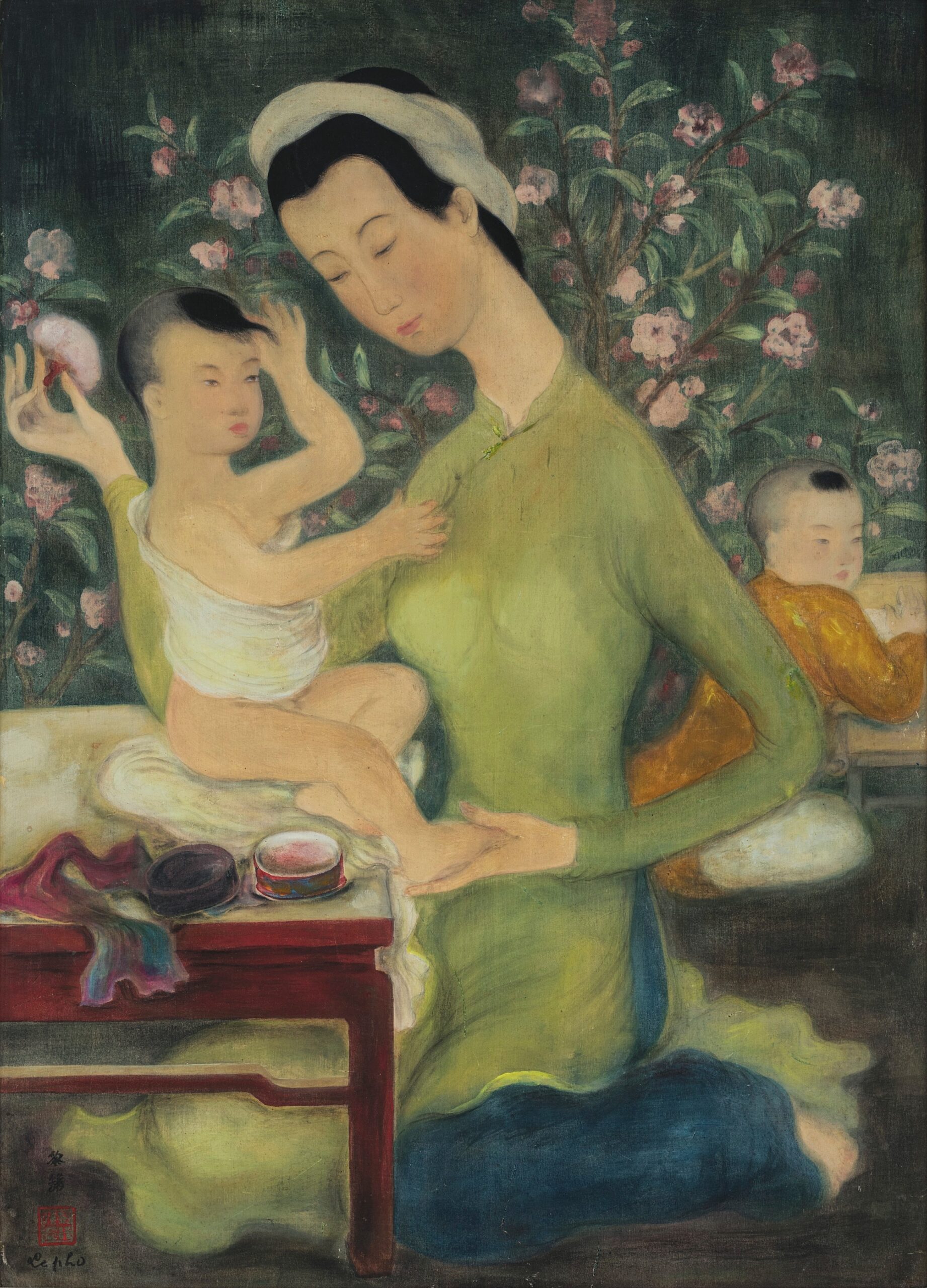
Le Pho (1907-2001)
La Toilette de l'Enfant (Child Bathing)
signed in Chinese, signed Le Pho (lower left); titled and inscribed 'toilette de l'enfant No. 5' with a stamp from Algerian customs (on the reverse)
ink and gouache on silk
62.5 x 45 cm. (24 5 ⁄ 8 x 17 3/4 in.)
Painted circa 1938-1940
LE PHO, LA TOILETTE DE L’ENFANT: THE UNREASONABLE SILENCE OF THE WORLD
The painting depicts two children with their mother, and central to the painting, the woman takes care of the youngest child while, in the background, the other child sits quietly.
All of Le Pho’s pictorial characteristics of his late 1930s paintings are found here: the signature bottom left using a smaller stamp, the elegant and beautiful Tonkinese woman dressed in her traditional pear-green ao dai, the healthy children with the classical hair tuft - which in ancient times was meant to protect the child’s sinciput - and the delicate care given to the depiction of the three characters’ very beautiful faces (in his later works, he would simplify the faces more and more). Other trademark characteristics of his silk painting from this early period include the billowy movement of the scarves: the blue linen placed on the table on the left, but also the white sheet around the body of the first child and the ao dai spread under the table; the Tonkinese bourgeois furnishings with the orange lacquered table in the foreground, on which rests, in addition to the cloth, a talcum powder box and its lid placed next to the child, both on the cloth.
At this time, Le Pho liked to represent in his works a bowl, a vase, or a box, simply placed on a table. The abundance of camellias in the background would place the scene on a veranda. Finally, Le Pho offers a perfect mastery of gouache and ink techniques on silk laid down on paper. He refined these techniques over a period of 30 years, abandoning oil on canvas only until 1963.
The figures are placed at an angle, which is Le Pho’s chosen posture for his characters, in order to suggest a presence rather than a mere statuesque exhibition.
The choice of colours also reflects the late 1930s. The painter would only lighten his palette, following Matisse’s advice, after meeting him in 1943. However, the blue of the lady’s pants and the orange of the child’s shirt on the right already foretell this evolution, while the pear-green of the tunic and the black of the hairstyles are classics in Le Pho’s work.
The flowers here are Camelias amplexicaulis (Hoa Hai Ðuong) which bloom from late fall to very early spring in northern Vietnam. Le Pho demonstrates his love of flowers and botany throughout his work. His ‘bouquets’ are always painted from ‘freshly cut flowers,’ as he used to tell me every time we looked at his paintings together. Le Pho, in this case, favours these Camelias, found not far from Hanoi, in the Tam Dao in 1910 (unfortunately, they longer exist in the wild since 2018).
A ballet of hands in a quadrilateral structure is the composition. The handwritten title, La Toilette de l’Enfant (Child’s grooming), titled by the artist at the back of the painting, refers to the child on the left, the central subject of the work, as he caresses his tuft hair distorting the tradition as if he knew it was ineffective. His right hand, touching his mother, reassures him. The woman with her left hand delicately holds the child’s right foot while her right hand appears to hold the puff intended to talc the child, signifying maternal attention and certainty. The talcum powder box, with its lid next to it, testifies to the immanence of the world, where the box somehow feels it has deeper symbolism and importance as the main protagonist.
However there is never a frivolity to Le Pho’s works. With him, everything is an allegory. And Le Pho offers this figurative thought with his usual subtlety. Already visible as a clue: Le Pho has learned the lesson of the Italian Renaissance. He saw that his counterpart's painters identified, according to the ancient Roman tradition, the direction on the right as auspicious and that on the left as negative. However, it is the subject that gives the meaning and here it is the child who looks to the right, and the mother looks down towards the child. The child in the back - whose hands are not shown in the picture also looks to the right.
La Toilette de l’Enfant is a scene from Vietnam but painted in Paris, where Le Pho settled permanently in 1937, with his desire to challenge himself and to master his craft. Like the majority of the painter’s works, it is tinged with the memory of the native country and bears the seal of nostalgia but of a conquering nostalgia. One that pushes you to question what Albert Camus, his contemporary, named in “The Myth of Sisyphus” (1942), “the unreasonable silence of the world”. Le Pho tells us: the child after the bath, on the left, is in fact him when he paints this splendid picture. In the background, on the right, the second child is also him, in the past, as he is leaving. And this caring mother-lady is Vietnam preparing him for the West.
Yes, at the end of the 1930s, Le Pho, in this magnificent work invited us to come to his life: the lid will never be set back on the talcum box.
Jean-François Hubert
Senior Expert, Vietnamese Art










